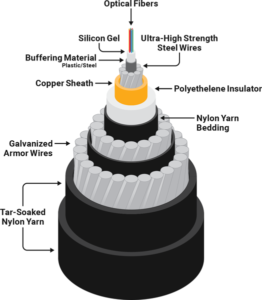The Future of Submarine Cabling

Submarine cabling is not a new concept, in fact, it was first implemented in 1858, connecting Newfoundland and Ireland through a telegraph cable that was placed deep beneath the sea’s surface. Whilst this was revolutionary at the time, the first non-test message that was sent was a 509-letter message that took 17 hours and 40 minutes to be delivered across the Atlantic ocean. However, since those times, the technology and techniques used have drastically changed (and improved) for the better.
Submarine cables
A submarine cable is a communications cable which is laid beneath the ocean’s surface that provides data transfer from one land-based location to another. Varying in size, the cables are equipped to withhold any environmental elements which may be present within the sea, as well as the depth of water in which they are situated.
Historically, submarine cables took approximately four years to install, lasting only one month before breaking down due to the harsh conditions. First constructed from a telegraph line, submarine cables have progressed to telephone and coaxial lines, with all modern submarine cabling using fiber optics.
Today, the fiber-optic technology uses lasers which send rapid waves down through thin glass fibers (optical fibers) to the other end of the cable. The filaments (fibers) are protected by layers of insulation as they are as thin as a strand of human hair. The cables that are laid within shallow water are much stronger and thicker than those located deeper within the ocean as they have to withhold tougher conditions.
Future of submarine cabling
There are three main ways to transmit data signals across large spans of land (phone cable, coaxial cable and fiber optic cables) which either send data through the air or through the sea. With 99% of internet data sourced from submarine cables and more than 380 active cables lying on the bottom of the ocean, the need for submarine cables is evident.
The demand for internet is expanding and the need for faster, more reliable service is here. In fact, the demand for global bandwidth is growing at up to 40% each year with analysts predicting the installation of fiber optic cables to hit the 2 million kilometer range by 2020. It is expected that 53.7% of the world’s population will have access to the Internet by 2021 which equates to an estimated 4.3 billion people. The submarine network is the most reliable and cost-effective solution in keeping up with such demand with submarine internet cable bandwidth continually increasing. As such, the 6600km MAREA cable which spans between Virginia and Spain is equipped to carry 160 terabits of data per second.
Whilst submarine cabling is a slow and expensive project, it is still the cheaper and faster alternative to satellites. Although both options are still susceptible to vulnerability and damage, it is far less likely for subsea cables to suffer from threatening damage. A single cable can carry tens of terabytes of information per second where satellites fall short, being able to only carry approximately one terabyte per second. With new phase modulation techniques and advancements in submarine equipment, the capacity has increased to 8000% ensuring that submarine networks are well prepared for the heightened demand of data and internet traffic.
The range of VIAVI testing and monitoring tools are designed specifically to handle all aspects of the submarine cable network, from the building stage right through to activation and monitoring. The submarine network typically poses unique obstacles due to the environment and conditions that the cables are situated within which is why it is critical to be equipped with the right instruments. As such, the entire architecture of a typical submarine cable network is divided into elements (wet plant, dry plant, landing station, umbilical cables, lengths/distances and repeaters/amplifiers). Each element plays a crucial role in protecting and delivering the data throughout the network system. Protect and monitor the submarine network with end to end solutions from VIAVI.




